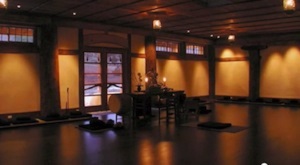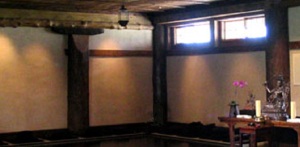Santa Fe zen – #2: forest for the trees
 Warm in the autumn mid-afternoon, I am lazily swooning in the fiery, shimmering gold of Colorado aspens in the high country. I see each fluttering leaf, smell the dry leaves underfoot, and hear the whispering quaking…and a guy cough. Next to me, on his meditation cushion. Which brings me back to reality, here in Upaya Zen Center, in Santa Fe, New Mexico. Again and again, my mind drifts with the cool breezes that curl in through the high windows of the zendo.
Warm in the autumn mid-afternoon, I am lazily swooning in the fiery, shimmering gold of Colorado aspens in the high country. I see each fluttering leaf, smell the dry leaves underfoot, and hear the whispering quaking…and a guy cough. Next to me, on his meditation cushion. Which brings me back to reality, here in Upaya Zen Center, in Santa Fe, New Mexico. Again and again, my mind drifts with the cool breezes that curl in through the high windows of the zendo.
 The trees. The aspens were spectacular this year, not just golden and bright as the sun, but flaming orange, and even red on a few mountain ridges. What incredible beauty I drove through to…breathe, and notice breathing, here in the zendo. Notice being here.
The trees. The aspens were spectacular this year, not just golden and bright as the sun, but flaming orange, and even red on a few mountain ridges. What incredible beauty I drove through to…breathe, and notice breathing, here in the zendo. Notice being here.
How many times do we not. In this day of silent meditation, my mind spins out stories, images, scents and sounds, until the windy rattling of the leaves of an entire aspen grove fills my mind with a completely false reality. It’s like napping with your eyes wide open.
“To be awake is to be alive.” — Henry David Thoreau, Walden Pond
The irony is that this Southwestern-style adobe Buddhist temple is spectacular, as well. Enormous posts of entire, peeled tree trunks anchor roughcut beams across the thick plaster walls. Rugged, natural wood is embedded over doorways and windows as reassuring lintels, sturdy vigas line the porch roofs and stud the smooth walls, and everywhere filtered light and softly moving air soothe and refresh. The floor is polished to a shine that reflects the light and shimmers like a lake, and I drift away in watery reveries repeatedly.
When I’m actually facing out into the room. Most zen meditation is done facing the wall. You sit maybe a foot or two away from the wall, and now, all distractions removed, you pay attention, to…sitting and breathing in front of a wall. It’s trickier than it seems, and not nearly as boring as it sounds.
Because our minds are such noisy places to live in. It’s exhausting when you first start to explore this mental terrain. That exhaustion quickly leads to the stage of life when you think you will move to a calm, quiet place, Thoreau’s cabin in the woods, where you can be happy and live simply. But what does it matter, if we live in an isolated cabin an hour from anywhere or in the middle of New York, if we bring the constant chatter-talk-drama-sirens-blaring-teary-confessions-angry-yelling-windows-breaking-hopeless-addict-craving-thrills-success-and-money-fame-nirvana with us everywhere we go?
Zen: sit down, shut up, face your wall.
Or in my case, face your tree.
See the very thick post on the left wall? That’s my tree. My assigned seat for the weekend was directly, exactly, in front of it. As you enter the sacred space, you bow to it, hands together. You walk slowly to your place, turn to face the room, and bow to all. You turn to your seat, and you now bow to it, this humble place that is the soil of the seed of your potential wisdom.
“All change is a miracle to contemplate; but it is a miracle which is taking place every instant.” — Thoreau
We do not bow, in general, in America. Honoring is a pageant here, not an act of humility – an awards ceremony, 21-gun salute, Oscar nomination for Best Picture, valuable cash prizes. But outside the pageant, in our daily lives, we curse each other in road rage, roll our eyes and sigh while in line for our five dollar coffees, and tell little cutting stories about how our kids are actually somewhat superior to your kids gosh look at the time gotta go. We compete with each other for what shimmers like glory, that fleeting popularity, status and bragging rights, instead of offering genuine respect and honor to each other, intentionally, and with all sincerity. Seems we won’t bow to the forest for all the damn trees.
So, I bowed to the temple, and I bowed to the sangha of fellow human beings, and I bowed before I took my seat, and then, I bowed to my tree. With all sincerity. As Robert Frost would have said, my tree was “lovely, dark, and deep,” the grain a fingerprint of its life, with swellings and whirls where branches might once have been. As I sat examining its scars, it occurred to me that trees seem like the most enlightened living beings on the planet, which I know makes me sound like a kook. But when you think about it, trees: demonstrate no passions, aggressions, or ignorance; are nobly rooted to the earth and stretch their crowns toward heaven, just as we are instructed to do in zazen; engage in no profane words or deeds; live according to the seasons of their lives; shelter smaller living things that seek them; make their own food, plus food and oxygen to nourish and sustain all life on this planet; inspire us with their simple beauty and fitness of purpose, as true bodhisattvas do; and demonstrate their enlightenment by their ability to bend and bow, honoring the way life is, instead of fighting to have their way.
“I turned my face more exclusively than ever to the woods, where I was better known.” — Thoreau
 Such a small space, between me and my tree, between me and the guy next to me, who still occasionally coughed. I looked deeply into that trunk before me, and saw generations of trees, growing together, just like we were all trying to grow together, sitting side by side. Just like aspen, we are all one organism below the surface, appearing as separate individuals – but that is actually an illusion. What we do to one, what we do to each other, we do to all. We do to ourselves. Because we act upon the whole world, whether in rage or in humility.
Such a small space, between me and my tree, between me and the guy next to me, who still occasionally coughed. I looked deeply into that trunk before me, and saw generations of trees, growing together, just like we were all trying to grow together, sitting side by side. Just like aspen, we are all one organism below the surface, appearing as separate individuals – but that is actually an illusion. What we do to one, what we do to each other, we do to all. We do to ourselves. Because we act upon the whole world, whether in rage or in humility.
I swayed with the aspens periodically, but that solid trunk, unmoving before me, would bring me back. And so did the very humanness of the people sitting beside me, many trees within the Circle of the Way.
“I went to the woods because I wished to live deliberately, to front only the essential facts of life, and see if I could not learn what it had to teach, and not, when I came to die, discover that I had not lived.” — Thoreau, Walden Pond




